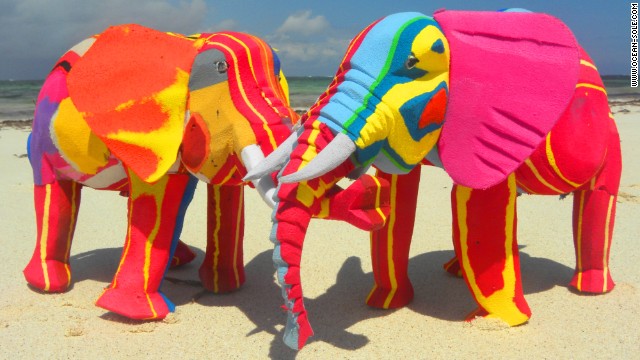Marine debris is transformed into art for a new exhibit at the Anchorage Museum, offering an eerie look at Earth's plastic problem.
Published Fri, Feb 21, 2014 in the Mother Nature Network by Russell McLenden

"Ghost Dog," made from recycled wire, synthetic ghost net, beach rope and thread. (Photo: Sue Ryan/Anchorage Museum)
From the Great Pacific Garbage Patch to Great Lakes microbeads,
plastic pollution has become an increasingly widespread and well-known
problem in recent years. But while most people now realize plastic trash
kills sea turtles, seabirds and other aquatic animals,
few of us ever see this ecological scourge once it escapes into the
wild. Rallying public interest can be hard when a problem seems faraway
and faceless.
But a new exhibit at Alaska's Anchorage Museum is designed to fight
that disconnect, using art made from marine debris to capture our
attention and help us visualize what's happening to Earth's oceans. "Gyre: The Plastic Ocean"
is a 7,500-square-foot collection of impressive but unsettling artwork
that "explores the relationship between humans and the ocean in a
contemporary culture of consumption." It features 80 pieces by 26
artists from Australia to Finland, all made with debris collected from
oceans, coasts and waterways around the world.
Along with this eerie assortment of art (see photos below), the exhibit also presents a National Geographic film, documentary photography and other findings from a 2013 scientific expedition
that studied wayward garbage in Alaskan waters. That voyage included
scientists from the Alaska SeaLife Center, Blue Ocean Institute,
Smithsonian Institution and the U.S. National Oceanic and Atmospheric
Administration, but it also carried artists, educators and filmmakers.
Some of the artwork in the exhibit was made from trash collected during
that expedition.
Being reminded about the scope of plastic pollution can be
discouraging, even depressing, but that's not the goal of "Gyre."
Instead, the exhibit's organizers say they want to help people confront
the problem by presenting it in a novel, interesting way, and then help
them realize it's not too late to do something about this man-made mess.
"Humankind has certainly imposed its footprint on this landscape, but
we have not ruined it," says Julie Decker, Anchorage Museum director and
exhibit curator, in a press release
about the show. "Plastic is a modern material, so this is a modern and
recent problem. That means there are things we can do, individually and
collectively, to reverse the impacts."
"Gyre" opened this month and is slated to run until Sept. 6, so
stop by if you're in Anchorage before then. (It's just one of several
collections at the city's 170,000-square-foot art, history and science
museum, which finished a $106 million expansion in 2010 and draws about
160,000 visitors per year — nearly a quarter of Alaska's population.) In
the meantime, here's a brief preview of the exhibit's haunting artwork:

John Dahlsen/Anchorage Museum
John Dahlsen, "Thongs," digital print on canvas.
Measuring 9 feet wide and 4 feet tall, this giant photograph offers a
bird's-eye view of more than 1,000 discarded sandals. Dahlsen personally
collected each of the sandals pictured, mainly from remote beaches in
Australia.

Susan Middleton/Anchorage Museum
Susan Middleton, "Shed Bird Stomach Contents," digital print.
Middleton observed an albatross chick for two months as its parents
unwittingly fed it inedible plastic. The chick later died with an
impacted stomach, the contents of which are revealed in this sad photo.

Chris Arend/Anchorage Museum
Rebecca Lyon, "Plastic Death," mixed media, Pratt Museum collection.
Lyon, an Alaska Native artist, says she mixes traditional and modern
styles "to highlight her culture's reverence for the natural world." In
this piece, a human face spews plastic from atop a whale that's been
harpooned by plastic spears and also has a belly full of plastic,
"demonstrating that convenience has had unexpected, toxic results."

Anne Percoco/Anchorage Museum
Anne Percoco, "Indra's Cloud," post-consumer plastic bottles.
This "cloud" is a mobile public sculpture, originally created in 2008,
that Percoco made by sewing together 1,000 plastic bottles found along
India's notoriously polluted Yamuna River.
She built a new, site-specific version from recycled plastic for the
Anchorage Museum exhibit, which also features photo documentation of her
"Indra's Cloud" project.

Chris Arend/Anchorage Museum
Cynthia Minet, "Sled Dogs," post-consumer plastic and LEDs. Minet, who's known for her series of recycled-plastic animal sculptures, says the visible use of electricity (via energy-efficient LEDs) is a comment on waste and a reflection on our complex relationships with nature.

Judith Selby and Richard Lang/Anchorage Museum
Judith Selby and Richard Lang, "Shovel Bands," digital print.
Over the past 15 years, California-based artists Selby and Lang have
taken hundreds of walks along the same 1,000 yards of Kehoe Beach in the
famed Point Reyes National Seashore.
They collect pieces of washed-up plastic trash as they go, curating
them over time to create "works of art that depict, with minimal
artifice, the material as it is."

Steve McPherson/Anchorage Museum
Steve McPherson, "28 Objects that Measured the World," found plastic objects, entomology pins.
British beachcomber McPherson also scours his local shores for plastic
debris, which he arranges into tidy "taxonomies" of discarded objects
that evoke slices of human history.

Chris Arend/Anchorage Museum
Mark Dion, "Cabinet of Marine Debris," mixed media.
Order is not a common quality of trash, so seeing marine debris
organized neatly in a cabinet can force us to see it with fresh eyes.
This effect is a hallmark for Dion, a renowned visual artist and mentor at Columbia University
who's known for his "spectacular and often fantastical curiosity
cabinets [that] exalt atypical orderings of objects and specimens."

Chris Arend/Anchorage Museum
Pam Longobardi, "Dark and Plentiful Bounty," mixed media. Inspired by piles of plastic she'd seen wash ashore in Hawaii, Atlanta-based Longobardi launched the Drifters Project
in 2006 and began making art primarily from marine debris. "I approach
the sites as a forensic scientist," she writes on her website,
"examining and documenting the deposition as it lay, collecting and
identifying the evidence of the crime."
Related marine debris stories on MNN:










